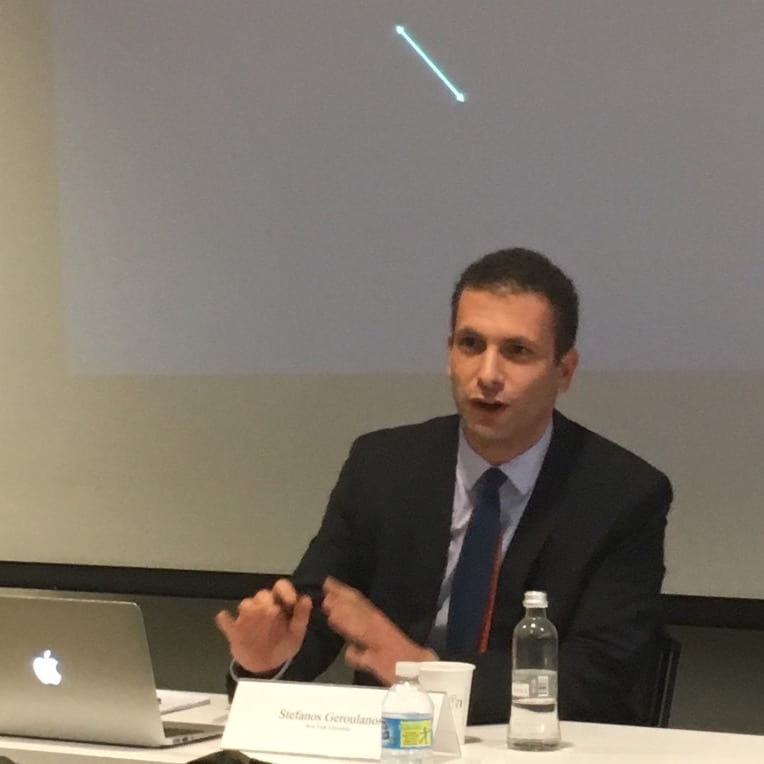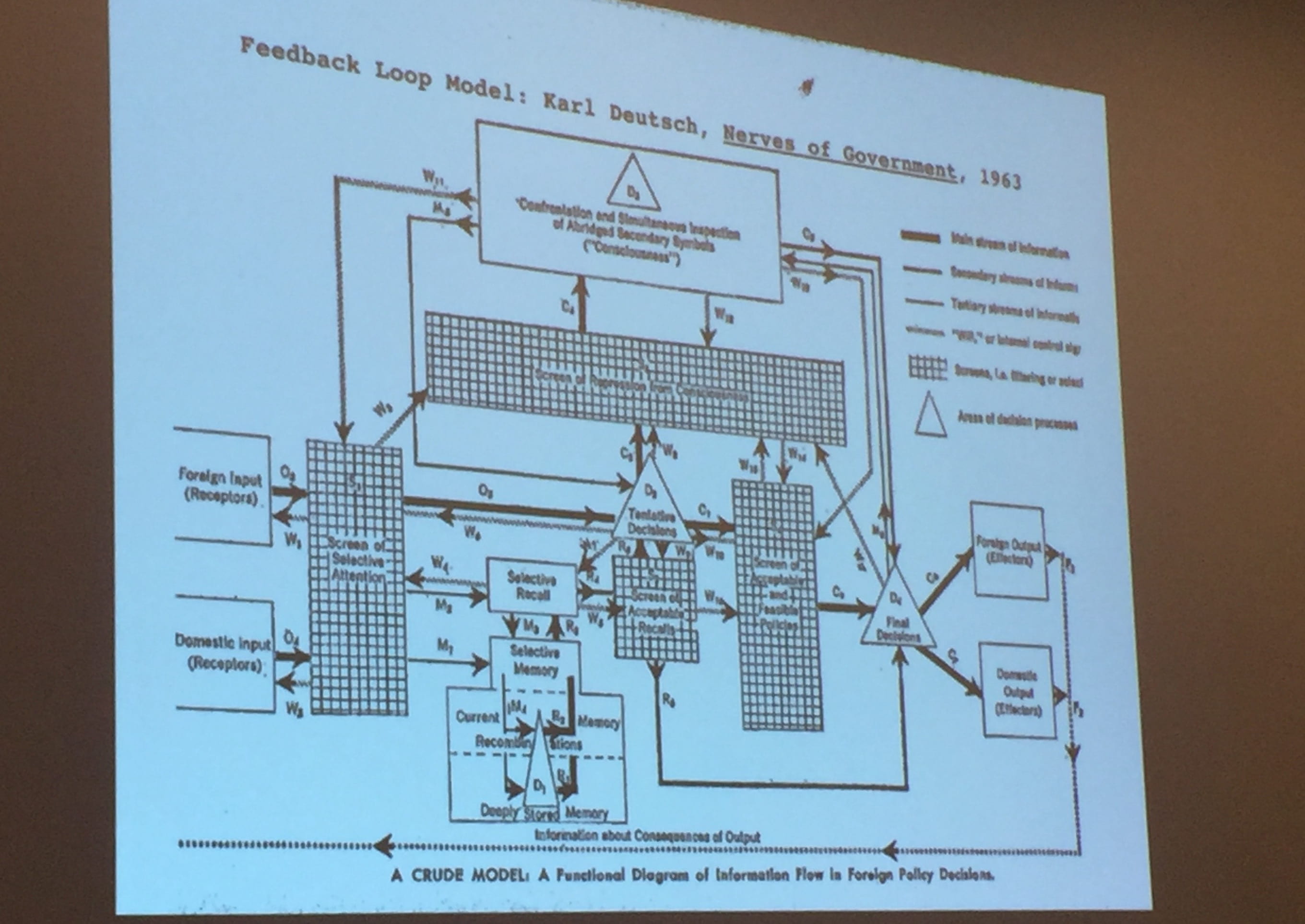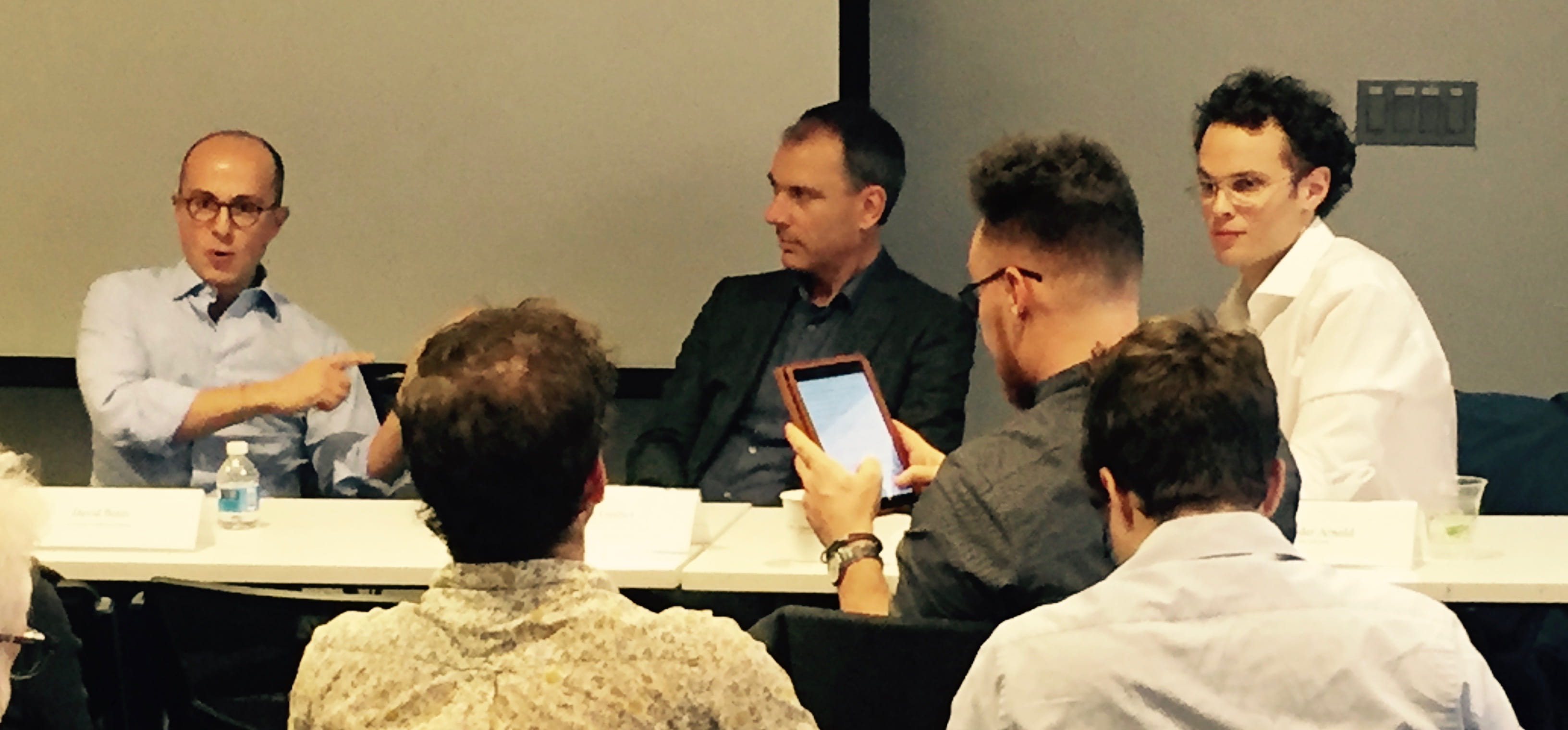by guest contributor Jamie Phillips
Rare the conference attracting a crowd on a cold December Saturday morning, but such happened recently at NYU’s Remarque Institute. Space filled out early for the conclusion of a two-day conference on Cybernetics and the Human Sciences (PDF). The turnout bore out the conference’s contention of a renewed historiographical and philosophical interest in cybernetics, the science of “control and communication in the animal and the machine,” as Norbert Wiener subtitled his 1948 work that gave the interdisciplinary movement its name. As Leif Weatherby, co-organizer of the conference along with Stefanos Geroulanos, noted in his introductory remarks, the twentieth century was a cybernetic century, and the twenty-first must cope with its legacy. Even as the name has faded, Weatherby suggested, cybernetics remains everywhere in our material and intellectual worlds. And so for two days scholars came to cope, to probe that legacy, to trace its contours and question its ramifications, to reevaluate the legacy of cybernetics as a history of the present.
The range of presenters proved particularly well-suited to such a reevaluation, with some working directly on cybernetics itself, while others approached the subject more obliquely, finding, as it were, the cybernetic in their work even where it had not been named. Ronald R. Kline, author of the recent The Cybernetics Moment: Or Why We Call Our Age the Information Age, set the tone early in emphasizing the disunity of cybernetics. Despite the claims of some of its advocates and latter-day commentators, Kline contended, cybernetics never was one thing. On this point general consensus emerged the conference tended to eschew a search for definitions or classifications in favor of a wide-ranging exploration of the many faces of cybernetics’ legacy. And wide-ranging it indeed was as papers and discussion touched on topics from international relations theory and the restrainer of the Antichrist, to Soviet planning in Novosibirsk, the manufacture of telephones, brain implants and bullfights, Voodoo death, and starfish embryos.
A number of papers spoke to the pre-history (or rather pre-histories) of cybernetics. Mara Mills emphasized the importance of the manufacturing context for the emergence of ideas of quality control, as a crucial site for the development of cybernetic conceptions of feedback. Geroulanos addressed physiological theories of organismic integration, stemming from WWI studies of wound shock and concerns with the body on the verge of collapse, and leading to Walter B. Cannon’s concept of homeostasis, so pivotal for early cyberneticians. Other papers spoke to the varying trajectories of cybernetics in different national contexts. Diana West discussed the appeal of cybernetics in the Soviet Union in the 1970s and 1980s as offering promise of a more dynamic form of large-scale regional planning, a promise expressed in abstract theoretical modeling and premised on a computing power that never came. Isabel Gabel explored the intersections of biology, embryology and metaphysics in the work of French philosopher Raymond Ruyer. Jacob Krell gave an entertaining appraisal of the strange humanist engagement with cybernetics by the heterogeneous “Groupe des dix” in post-68 France, while Danielle Carr spoke to the anxious reaction against visions of human mind control in the Cold War United States, through the work of José Manuel Rodriguez Delgado. Other papers still, particularly those of Weatherby and Luciana Parisi, directly confronted a cybernetic metaphysics, and between them they raised questions concerning its novelty and significance with respect to the history of philosophy and contemporary media theory.

Stefanos Geroulanos
Taken together, the papers compellingly demonstrated the ubiquity and diversity of the cybernetic across disciplines, decades, and geographical and political contexts. Taken together, however, they also raised a question that has long been posed to cybernetics itself. Here we might cite the words of Georges Boulanger, president of the International Association of Cybernetics, who asked, in 1969: “But after all what is cybernetics? Or rather what is it not, for paradoxically the more people talk about cybernetics the less they seem to agree on a definition” (quoted in Kline, The Cybernetics Moment, 7). Indeed, just as cybernetics itself declined as it expanded into everything, there is perhaps a risk that in finding cybernetics everywhere we lose hold of the object itself. To push the point further, we might echo the frustration of one of the interviewees cited by Diana West in her talk (and here I paraphrase): ‘They promised us cybernetics, but they never gave us cybernetics.’
Over two days, the conference answered this challenge through the productive discussion it generated. The more people talked about cybernetics, the more they seemed to find common ground for engagement.. Beyond the numerous schematics that served as the immediate graphic markers of the cybernetic imagination (see image), conversation coalesced around a loose conceptual vocabulary—of information, of feedback and system, of mechanism and organism, of governance, error and self-organization—that effectively bridged topics and disciplines, and that gave promise of discerning a certain conceptual coherence in the cybernetic age.

A cybernetic schematic: “A Functional Diagram of Information Flow in Foreign Policy Decisions,” from Karl Deutch’s 1963 The Nerves of Government (courtesy of Stefanos Geroulanos)
This proved true even when (or perhaps especially when) understandings of the cybernetic seemed to point in very different directions. A panel of papers by David Bates and Nicolas Guilhot was particularly exemplary in this regard. Bates and Guilhot brought contrasting approaches to the question of the political in the cybernetic age. Bates presented his paper in the form of a question—on the face of it paradoxical, or simply unpromising—of whether we might think a concept of the political in the cybernetic age through the work of Carl Schmitt. Referring to Schmitt’s concept of the katechon (from his post-war work The Nomos of the Earth) as the Restrainer of the Anti-Christ, Bates proposed thinking the political as a deferral of chaos, a notion he linked to the idea of an open system that maintains itself through constant disequilibration, and to an organism that establishes its norms through states of exception. Recalling, through Schmitt, Hobbes’ conception of the Leviathan as an artificial man in which sovereignty is an artificial soul, Bates argued for a concept of the political that would enable us to think mechanism and organism together, that could recover the human without abandoning technology.

Nicolas Guilhot, David Bates, and Alexander Arnold (courtesy of Stefanos Geroulanos)
Guilhot, by contrast, looked at the place of cybernetics in international relations theory and the work of political theorists in the 1960s and 1970s. Cybernetics, Guilhot suggested, here offered the promise of an image of the political that was not dependent on sovereign actors and judgment, one that could do away with decision making in favor of structure, system, and mechanistic process. Where Bates expressed concern that the technical had overrun the capacity of humans to participate in their own systems, for Guilhot’s theorists this was precisely the appeal: coming at a moment of a widely perceived crisis of democracy, cybernetics promised to replace politics with governance as such. For Guilhot here too, though, there was a critical intervention at stake: the image of the political as a system does not remove decision making, he contended, but rather obfuscates it. Prompted by the panel chair to respond to each other directly, Bates and Guilhot agreed that their papers were indeed complementary, with Bates speaking to an earlier moment of concern in the history of cybernetics that had subsequently been lost. The lively discussion that ensued served as proof of the productive engagement that can come from bringing it to the fore again.
Seen in this light, it was a fitting—if unwitting—coda to the conference as a whole that the menu at the post-conference lunch that Saturday afternoon rendered the title of the conference as “Cybernetics and the Human Services” (see image). One might take this as an occasion to think about the flow of information, about the place of error in systems of control and communication. But for present purposes, and for the present author, this fortuitous transposition of ‘human sciences’ into ‘human services’ serves rather to bring to the fore the question implicit in the conference’s agenda: how does the effort to reevaluate the legacy of cybernetics as a single history of the present change our possibilities for understanding and acting within it. What service, in short, can the human sciences render?

(© Jamie Phillips)
In his paper that concluded the conference, Weatherby referred to an occasion at one of the Macy Conferences where the participants, considering the question of whether the brain was digital, confronted the further problem of defining the digital itself. Here, Weatherby suggested, they suffered from a lack of contribution from the humanities—no participant could themselves help the group to arrive upon a definition of cybernetics, what it does, how it works. Such is the work, it seems, that awaits the return to cybernetics. As the conference amply demonstrated, this will not and cannot be simply a matter of narrow definition: any attempt to come to terms with the cybernetic age and our continued place within it must pay heed to the pluralities, the disunities, the dispersed and intertwined trajectories that constitute that legacy; for all its own promise to unify the sciences, cybernetics was never one thing. At the same time, coming to terms with the cybernetic age will entail an effort to find a commonality in the plurality: if cybernetics indeed saturates the human and social sciences, how can we distill it; if it is everywhere without being named, what does it mean to name it, and what does it allow us to see. In this respect, one hopes, the menu will not be the last word, but will point rather to the urgency of continuing the ongoing reevaluation. An edited volume, I am told, is in the works.
Jamie Phillips is a Ph.D. candidate in modern European history at NYU. His dissertation examines the history of psychoneurology as a total science of the human in early twentieth century Russia, and its relation to the project of creating a ‘New Man.’



Leave a Reply